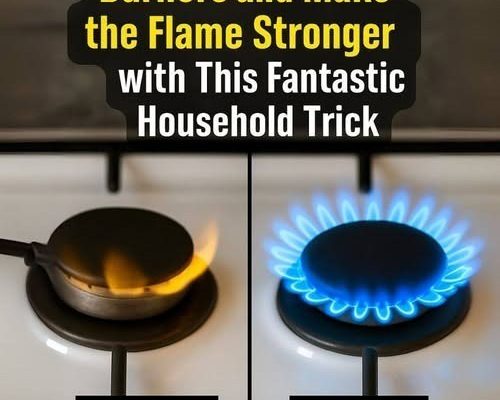If your gas stove’s flame has turned weak, uneven, or flickering, the problem is usually blocked nozzles. Over time, grease, oil vapor, food residue, and dust collect in the narrow passages where gas escapes. That buildup chokes the flow, making your flame small and unstable. Cooking takes longer, heat distribution becomes uneven, and you waste more gas than you realize. The good news: you can fix it yourself in less than an hour, without calling a technician or spending money on specialized tools.
The process is straightforward. You’ll clear the gas nozzles, remove buildup inside the tubes, and restore a full, strong flame. This method uses simple items found around the house, yet it delivers professional-level results when done right.
First, gather what you need. A mild aluminum-safe cleaner is ideal because it’s strong enough to dissolve grease without corroding the metal. A slim wooden stick or the handle of a wooden spoon will let you gently reach into the nozzle opening. Finally, soft tissue or toilet paper will help you wipe away loosened grime and moisture. Avoid metal tools or harsh chemicals—they can damage the nozzle or leave residues that affect ignition.
Before you start cleaning, make safety your priority. Turn the stove off completely and close the gas valve. Wait until all parts are cool to the touch. Remove the burner grates and caps to expose the nozzles. If your model has removable burners, take them out carefully and set them on a towel nearby. Make sure your workspace is well-lit and ventilated.
Now apply the aluminum cleaner. Pour or dab a small amount directly over each nozzle head. Don’t soak them—just enough to cover the surface. Let the cleaner sit for five to ten minutes. During that time, it will break down greasy buildup and soften any hardened food residue inside the openings. The cleaner works on a microscopic level, loosening the dirt that’s clogging the tiny gas channels. Never substitute with strong acids or industrial cleaners; those can corrode or discolor the burner metal permanently.
Once the cleaner has done its job, use the wooden stick or spoon handle to carefully dislodge debris from the nozzle openings. Gently insert the tip into the gas tube and move it in small circles or short strokes. You’ll likely notice bits of black soot or grease falling out. That’s what’s been strangling your flame. Take your time and avoid pressing too hard. The goal is to loosen the grime without scratching the interior. Scratches can trap more residue later.
After dislodging the buildup, wipe everything clean. Use toilet paper or soft tissue to remove leftover cleaner and dirt. Make sure you clean the surrounding metal as well—grease tends to accumulate in those areas too. Once the visible residue is gone, let everything dry completely. Moisture trapped inside the nozzle can cause sputtering when you relight the burners. Air drying for 20 minutes is best, but you can speed things up with a cool hairdryer if needed.
Inspect each part before reassembling. The burner holes should be clean and open, not dark or greasy. The nozzles should look metallic, not dull. If you see cracks or corrosion, consider replacing the part instead of cleaning it again.
When all components are clean and dry, reassemble the stove. Put the burner caps and grates back in their correct positions. Reconnect the gas line and slowly turn the valve back on. Test one burner first. Light it carefully and observe the flame. It should be bright blue, steady, and evenly distributed across the ring. If the flame remains weak or yellow, repeat the cleaning process on that specific burner or double-check that the parts are properly seated.
A strong flame indicates full gas pressure and proper airflow. Once you see that improvement, test the other burners one by one. You’ll notice faster boiling times, more consistent cooking temperatures, and less fuel waste.
Keeping your stove in good condition doesn’t stop here. Regular maintenance is what prevents clogs from returning. Wipe down burners and caps weekly with warm soapy water. Every two to three months, repeat this deeper nozzle cleaning. Small, frequent cleanings are better than waiting until performance drops. When spills happen, clean them immediately instead of letting grease bake onto the metal.
Always stick with aluminum-safe cleaning solutions. They protect your stove’s finish and internal components. After cleaning or reassembling, do a simple gas-leak check: mix a bit of dish soap with water and brush it around the gas connection. If bubbles form, tighten the fitting immediately or call a professional.
Why does this method work so well? Because the main cause of weak flames isn’t a mechanical defect—it’s buildup inside tiny gas passages. The aluminum cleaner dissolves the fatty layer blocking airflow, and the gentle mechanical action from the stick clears anything the cleaner didn’t reach. You’re restoring the gas pressure balance exactly as designed. The difference in performance is immediate and visible.
Beyond stronger flames, this small routine saves money. A clogged burner makes your stove burn gas inefficiently. That means higher utility bills and more wear on the ignition system. Regular cleaning ensures smooth combustion, lower emissions, and longer burner life. It also reduces soot buildup, which helps keep your kitchen walls and pots cleaner.
If your stove has multiple burners with uneven strength, clean each one individually. Some may clog faster depending on usage. The front burners—especially the right side—tend to collect more residue from frying or boiling over. Focus extra attention there.
Treat this maintenance like tuning up a car engine. When gas and air flow evenly, performance improves across the board. Your cooking times drop, simmering becomes more precise, and even simple dishes taste better because of steady, even heat.
Most importantly, don’t wait until your flame looks bad to act. Prevention is easier than repair. Once or twice a season, give your stove this 30-minute care session. You’ll avoid unnecessary repairs and extend its lifespan by years.
It’s surprising how many people assume a weak flame means the stove is “old” or “worn out.” In most cases, it just needs cleaning. The burners and tubes themselves are durable; it’s the buildup that causes the problem. So before spending money on service calls or replacements, try this simple fix. You’ll likely see your flame return to full power, steady and blue, just like when the stove was new.
Keeping your kitchen appliances at peak efficiency doesn’t require complicated maintenance plans or expensive equipment. It just takes a bit of consistency, common sense, and attention to detail. Follow these steps regularly, and your gas stove will reward you with reliable heat, efficient performance, and years of trouble-free cooking.



